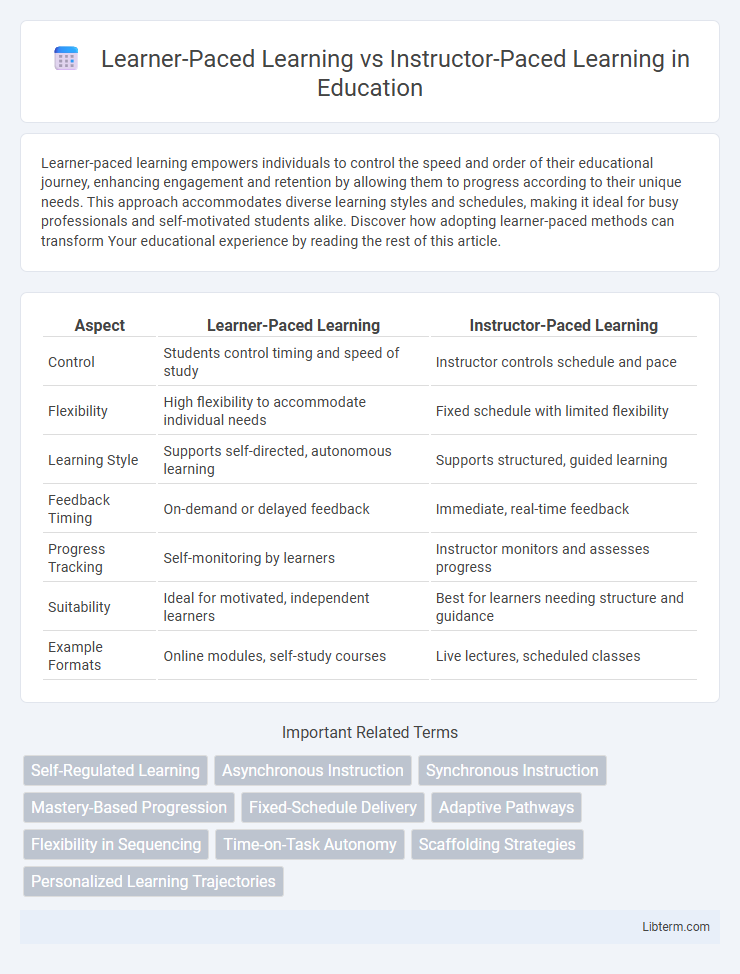Learner-paced learning empowers individuals to control the speed and order of their educational journey, enhancing engagement and retention by allowing them to progress according to their unique needs. This approach accommodates diverse learning styles and schedules, making it ideal for busy professionals and self-motivated students alike. Discover how adopting learner-paced methods can transform Your educational experience by reading the rest of this article.
Table of Comparison
| Aspect | Learner-Paced Learning | Instructor-Paced Learning |
|---|---|---|
| Control | Students control timing and speed of study | Instructor controls schedule and pace |
| Flexibility | High flexibility to accommodate individual needs | Fixed schedule with limited flexibility |
| Learning Style | Supports self-directed, autonomous learning | Supports structured, guided learning |
| Feedback Timing | On-demand or delayed feedback | Immediate, real-time feedback |
| Progress Tracking | Self-monitoring by learners | Instructor monitors and assesses progress |
| Suitability | Ideal for motivated, independent learners | Best for learners needing structure and guidance |
| Example Formats | Online modules, self-study courses | Live lectures, scheduled classes |
Introduction to Learner-Paced and Instructor-Paced Learning
Learner-paced learning allows individuals to control the speed and timing of their educational journey, fostering personalized engagement and flexibility suited to diverse learning styles. Instructor-paced learning follows a structured schedule determined by the educator, promoting uniformity, consistent progression, and real-time interaction within a group setting. Understanding these approaches helps optimize curriculum design by aligning teaching methods with learner needs and institutional objectives.
Defining Learner-Paced Learning
Learner-paced learning allows individuals to control the timing, speed, and sequence of their educational activities, accommodating diverse learning styles and schedules. This approach emphasizes self-directed study, enabling learners to review materials multiple times and progress upon mastering content, which enhances retention and comprehension. Unlike instructor-paced learning, it reduces dependency on fixed deadlines and instructor availability, fostering greater autonomy and personalized learning experiences.
Understanding Instructor-Paced Learning
Instructor-paced learning follows a structured schedule where the educator controls the pace and timing of content delivery, ensuring consistent progress for all students. This method facilitates real-time interaction, immediate feedback, and collaborative discussions, enhancing comprehension and engagement. It is particularly effective for subjects requiring guided practice and synchronized learning environments.
Advantages of Learner-Paced Learning
Learner-paced learning offers significant advantages such as personalized engagement, allowing individuals to absorb material at their own speed and revisit complex topics for better comprehension. This flexibility enhances knowledge retention and accommodates diverse learning styles, promoting deeper understanding and skill mastery. Furthermore, self-directed pacing reduces stress and fosters intrinsic motivation, empowering learners to take ownership of their educational journey.
Benefits of Instructor-Paced Learning
Instructor-paced learning offers structured guidance that enhances knowledge retention by following a well-defined curriculum and schedule. It promotes active engagement through real-time feedback and interaction, enabling learners to clarify doubts immediately. This approach also fosters discipline and motivation, helping students stay on track and meet learning milestones efficiently.
Challenges in Learner-Paced Learning
Learner-paced learning challenges include time management difficulties, reduced motivation, and potential isolation due to lack of real-time instructor interaction. Students often struggle with self-discipline, which can hinder progress and lead to incomplete comprehension of complex topics. Limited immediate feedback from instructors further complicates addressing misunderstandings in learner-paced environments.
Limitations of Instructor-Paced Learning
Instructor-paced learning often restricts flexibility, limiting students' ability to learn at their own speed, which can hinder comprehension and retention. The rigid schedule may not accommodate diverse learning styles or varying levels of prior knowledge, resulting in disengagement or frustration. This model can also reduce opportunities for personalized feedback and adaptation, impacting overall learning effectiveness.
Comparative Analysis: Learner-Paced vs. Instructor-Paced
Learner-paced learning empowers individuals to control the timing and speed of their educational engagement, promoting autonomy and catering to diverse learning speeds, while instructor-paced learning follows a structured timeline set by educators, ensuring consistent progress and alignment with curriculum standards. Research indicates that learner-paced environments enhance retention and satisfaction for self-motivated students, whereas instructor-paced settings benefit those who thrive under scheduled guidance and peer interaction. Effectiveness varies by context, with learner-paced models excelling in asynchronous online courses and instructor-paced formats preferred in traditional classroom environments requiring synchronized participation.
Choosing the Right Approach for Different Learners
Learner-paced learning offers flexibility and autonomy, allowing individuals to progress based on their comprehension and schedule, which suits self-motivated and independent learners. Instructor-paced learning provides structured guidance and fixed timelines, benefiting those who thrive with direct support and clearer deadlines. Selecting the right approach depends on factors like learner motivation, time management skills, and the complexity of the subject matter.
Future Trends in Educational Delivery Methods
Learner-paced learning increasingly leverages adaptive technologies and AI-driven platforms to offer personalized, flexible educational experiences, responding to individual progress and learning styles. Instructor-paced learning integrates hybrid models, blending synchronous and asynchronous elements to maintain structured guidance while accommodating digital collaboration tools. Future educational delivery methods emphasize scalability and accessibility, combining data analytics with immersive technologies such as VR and AR to enhance engagement and optimize learning outcomes across diverse environments.
Learner-Paced Learning Infographic

 libterm.com
libterm.com